Study on Characteristics and Optimal Layout of Components in Shallow Water Mooring System of Floating Wind Turbine
Abstract
1. Introduction
2. Methodology
2.1. Blade-Element Momentum Theory
2.2. Frequency Domain Analysis Theory
2.3. Time Domain Analysis Theory
3. Model Parameter
3.1. Winf Turbine Parameters
3.2. Parameters of Floating Platform
3.3. Mooring Parameters
3.4. Environmental Parameters
4. Numerical Simulation
4.1. Coupling Model Validation
4.2. Frequency Domain Hydrodynamic Analysis
4.3. Analysis and Comparison of Tensioned and Catenary Mooring Systems
4.4. Individual Accessory Parameter Sensitivity Analysis
4.4.1. Buoy Volume and Installation Location
4.4.2. The Mass of the Clump Weight and the Installation Position
4.5. Sensitivity Analysis of Accessory Combination Usage Parameters
5. Conclusions
- At small water depths, when the span between catenary and tensioned moorings is the same, the catenary mooring is better than the tensioned mooring in terms of droop and longitudinal rocking motion response and tension. In the aspect of surge, the positioning ability of the tensioned mooring is better than that of the catenary type, and the motion control ability is worse than that of the catenary type. Considering the advantages and disadvantages of both and the safe operation ability of floating wind turbines in complex marine environments, catenary mooring is a more suitable mooring mode.
- After the buoy and clump weight are added to the floating wind turbine mooring system, the surge and pitch motion responses can be obviously optimized, and the maximum of the mooring tension can be reduced, but the heave motion response is slightly increased due to the characteristics of the clump weight and buoy.
- When mooring accessories are used alone, increasing the volume of the buoy will increase the maximum value and average value of surge, heave and pitch, and the maximum value of tension will also increase; When the installation position of the buoy moves down within a certain range, the maximum and mean values of the pitch and pitch will increase, but the maximum and mean values of the heave will decrease, and the mooring line tension will also increase. The increase in the mass of the clump weight will reduce the maximum value and the mean value of the heave and pitch, the maximum value of the heave will increase but the average value will decrease, while the maximum value of the mooring line tension will decrease, and the amplitude of the oscillation will also decrease. If the installation position of the clump weight is moved backward within a certain range, the maximum value and average value of surge and pitch will increase, the maximum value of heave will decrease but the average value will increase, and the maximum value of tension and the amplitude of oscillation will increase.
- The combination of the use of accessories to change the parameters of the overall response of the floating wind turbine the same law as the use of accessories alone when changing the same parameters. However, the rate of improvement of the mooring system optimization by changing the mooring parameters when used in combination is higher than the result of changing the same parameters when the accessories are used alone; The optimization difference of the maximum heave motion response can reach 24.6%, and the optimization difference of the mean value can reach 30.1%. The surge, pitch and tension difference are basically within 10%.
- When changing the mass parameters of the clump weight, the maximum difference of the heave, pitch and tension response of the fan is 1.837% and the minimum is only 0.006% under the condition of the single and combined use of the accessories, which is much smaller than the optimization difference caused by changing other parameters. This shows that when changing the mass parameters of the clump weight, whether it is used in combination with the buoy has little effect on the overall response. So it is not difficult to see that the clump weight mass parameters have a greater impact on the mooring system than other parameters.
Author Contributions
Funding
Institutional Review Board Statement
Informed Consent Statement
Data Availability Statement
Acknowledgments
Conflicts of Interest
References
- Fan, K. Motion performance of floating offshore wind turbine platform in shallow water. J. Mar. Eng. 2021, 43, 71–76. [Google Scholar]
- Xu, K.; Gao, Z. Effect of hydrodynamic load modelling on the response of floating wind turbines and its mooring system in small water depths. IOP Publ. 2018, 1104, 012006. [Google Scholar] [CrossRef]
- Zhang, L.; Li, H. A combination mooring system and mooring characteristics study. J. Ship Mech. 2016, 20, 306–314. [Google Scholar]
- Finn, L.D. A New Deepwater Offshore Platform-The Guyed Tower. In Proceedings of the Offshore Technology Conference, Houston, TX, USA, 2–5 May 1976. [Google Scholar]
- Morrison, G.D. Guyed Tower with Dynamic Mooring Properties. J. Struct. Eng. 1983, 109, 2578–2590. [Google Scholar] [CrossRef]
- Chatjigerorgiou, I.K.; Mavrakos, S.A.; Papazoglou, V.J. Use of buoys for dynamic tension reduction in deep water mooring applications. In Proceedings of the 7th International Conference on the Behavior of Offshore Structures, Boston, MA, USA, 12–15 July 1994. [Google Scholar]
- Mavrakos, S.A.; Chatjigerorgiou, I.K. Deep Water Mooring Dynamics. Mar. Struct. 1996, 9, 181–209. [Google Scholar] [CrossRef]
- Mavrakos, S.A.; Chatjigeorgiou, I.K. Dynamic behaviour of deep-water mooring lines with submerged buoys. Comput. Struct. 1997, 64, 819–835. [Google Scholar] [CrossRef]
- Fitzgerald, J.; Bergdahl, L. Including moorings in the assessment of a generic offshore wave energy converter: A frequency domain approach. Mar. Struct. 2008, 21, 23–46. [Google Scholar] [CrossRef]
- Yuan, Z.M.; Incecik, A. Numerical study on a hybrid mooring system with clump weights and buoys. Ocean. Eng. 2014, 88, 1–11. [Google Scholar] [CrossRef]
- Xiao, Y.; Fu, Q. Study on dynamic response characteristics of floating fan mooring system. J. China Shipbuild. 2019, 60, 13. [Google Scholar]
- Xu, K.; Larsen, K. Design and comparative analysis of alternative mooring systems for floating wind turbines in shallow water with emphasis on ultimate limit state design. Ocean. Eng. 2021, 219, 108377. [Google Scholar] [CrossRef]
- Peric, M.; Tonkovic, Z. Numerical analysis and experimental investigation of welding residual stresses and distortions in a t-joint fillet weld. Mater. Des. 2014, 53, 1052–1063. [Google Scholar] [CrossRef]
- Adam, F.; Myland, T.; Schuldt, B.; Großmann, J. Evaluation of internal force superposition on a TLP for wind turbines. Renew. Energy 2014, 71, 271–275. [Google Scholar] [CrossRef]
- Vita, L.; Ramachandran, G.K.V.; Krieger, A.; Kvittem, M.I.; Merino, D.; Cross-Whiter, J.; Ackers, B.B. Comparison of Numerical Models and Verification Against Experimental Data, Using PelaStar TLP Concept. In Proceedings of the ASME 2015 34th International Conference on Ocean, Offshore and Arctic Engineering, St. John’s, NL, Canada, 31 May–5 June 2015. [Google Scholar]
- Madjid, K.; Torgeir, M. Feasibility of the Application of a Spar-type Wind Turbine at a Moderate Water Depth. Energy Procedia 2012, 24, 340–350. [Google Scholar]
- Sethuraman, L.; Venugopal, V. Hydrodynamic response of a stepped-spar floating wind turbine: Numerical modelling and tank testing. Renew. Energy 2013, 52, 160–174. [Google Scholar] [CrossRef]
- Utsunomiya, T.; Sato, T.; Matsukuma, H.; Yago, K. Experimental validation for motion of a spar-type floating offshore wind turbine using 1/22.5 scale model. In Proceedings of the ASME 2009 28th International Conference on Ocean, Offshore and Arctic Engineering, Honolulu, HI, USA, 31 May–5 June 2009; pp. 951–959. [Google Scholar]
- Roddier, D.C.; Cermelli, A.A.; Weinstein, A. WindFloat: A floating foundation for offshore wind turbines. J. Renew. Sustain. Energy 2010, 2, 53. [Google Scholar] [CrossRef]
- Duan, F.; Hu, Z.Q.; Wang, J. Investigation of the VIMs of a spar-type FOWT using a model test method. J. Renew. Sustain. Energy 2016, 8, 74–85. [Google Scholar]
- Martin, H.R. Development of a Scale Model Wind Turbine for Testing of Offshore Floating Wind Turbine Systems. Master’s Thesis, The University of Maine, Orono, ME, USA, 2011. [Google Scholar]
- Karimirad, M.; Michailides, C. V-shaped semisubmersible offshore wind turbine: An alternative concept for offshore wind technology. Renew. Energy 2015, 83, 126–143. [Google Scholar] [CrossRef]
- Paulsen, U.S.; Borg, M.; Madsen, H.A. Outcomes of the Deep-Wind conceptual design. Energy Procedia 2015, 80, 329–341. [Google Scholar] [CrossRef]
- Bedon, G.; Paulsen, U.S.; Madsen, H.A.; Belloni, F.; Castelli, M.; Benini, E. Aerodynamic Benchmarking of the Deepwind Design. Energy Procedia 2015, 75, 677–682. [Google Scholar] [CrossRef]
- Robertson, A.; Jonkman, J.; Masciola, M. Definition of the Semisubmersible Floating System for Phase II of OC4. In Proceedings of the National Renewable Energy Laboratory (NREL), Golden, CO, USA, 1 September 2014. [Google Scholar]
- Yi, H.; Sun, L. Hydrodynamic response modeling and analysis of tensioned mooring semi-submersible wind turbine platform. Chin. Hydraul. Pneum. 2021, 1, 79–84. [Google Scholar]
- Coulling, A.J.; Goupee, A.J. Validation of a fast semi-submersible floating wind turbine numerical model with DeepCwind test data. J. Renew. Sustain. Energy 2013, 5, 557–569. [Google Scholar] [CrossRef]
- Chen, Y.Y.; Zhang, Y.M. Dynamic response and mooring optimization of taut mooring floating wind turbine. China Offshore Platf. 2019, 34, 9. [Google Scholar]
- Liu, Z.; Tu, Y. Numerical analysis of a catenary mooring system attached by clump masses for improving the wave-resistance ability of a spar buoy-type floating offshore wind turbine. Appl. Sci. 2019, 9, 1075. [Google Scholar] [CrossRef]
- Hordvik, T. Design analysis and optimization of mooring system for floating wind turbines. Dep. Mar. Technol. 2011. [Google Scholar]
- Ma, G.; Zhong, L. Mechanism of mooring line breakage of floating offshore wind turbine under extreme coherent gust with direction change condition. J. Mar. Sci. Technol. 2020, 25, 1283–1295. [Google Scholar] [CrossRef]



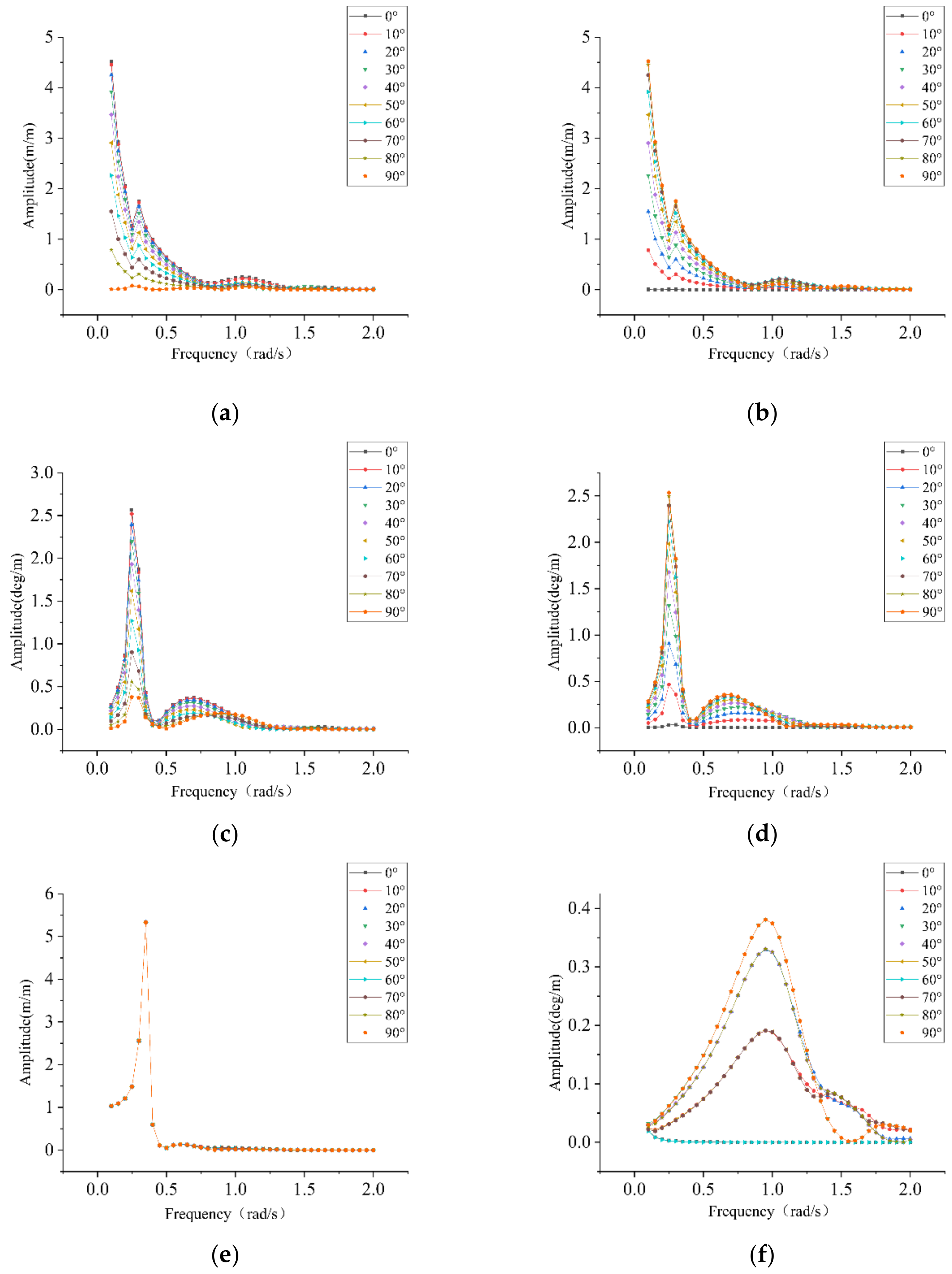

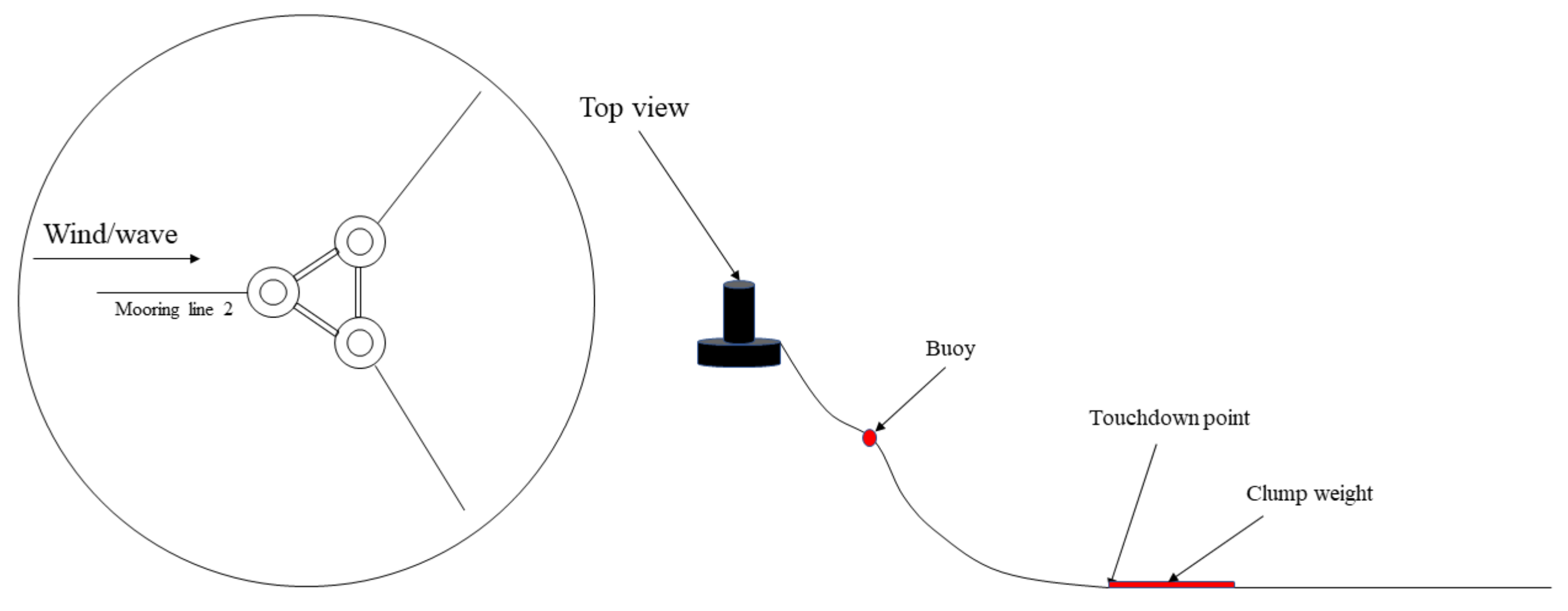
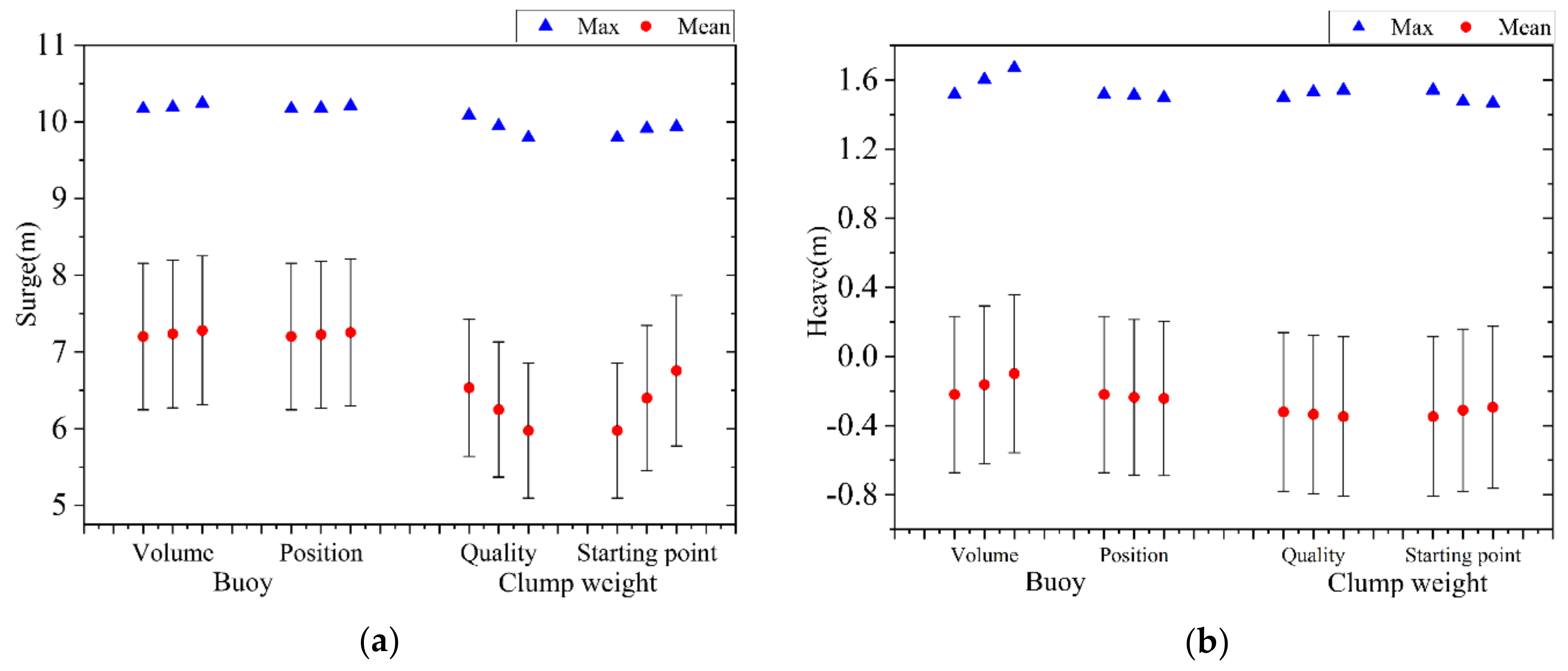
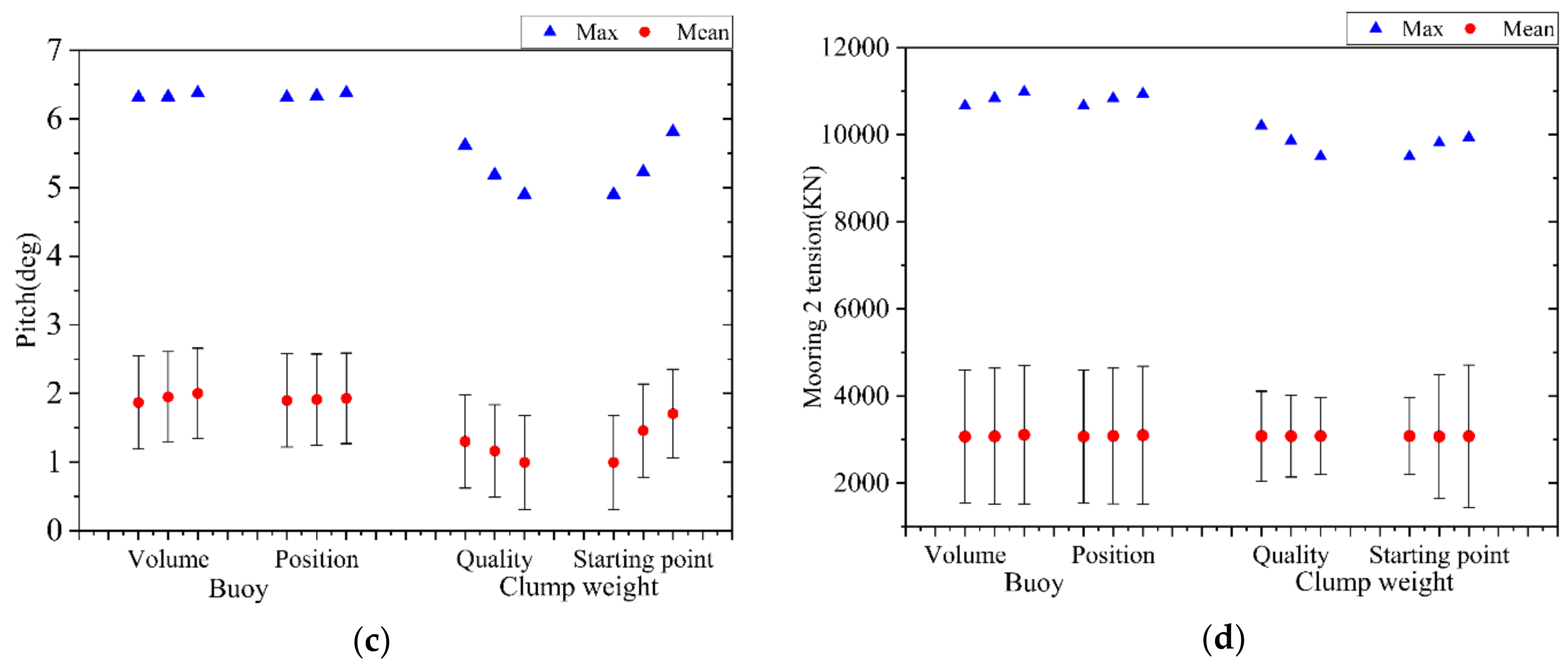
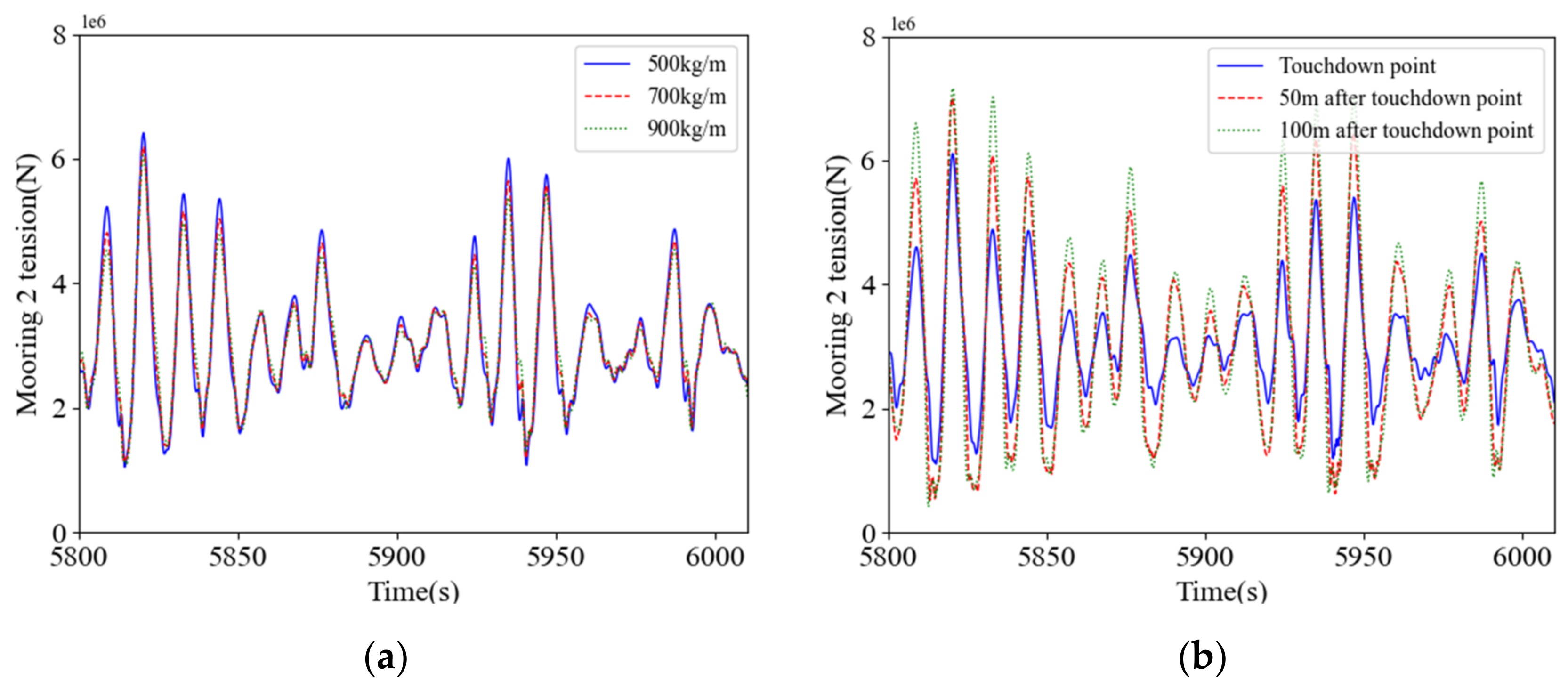
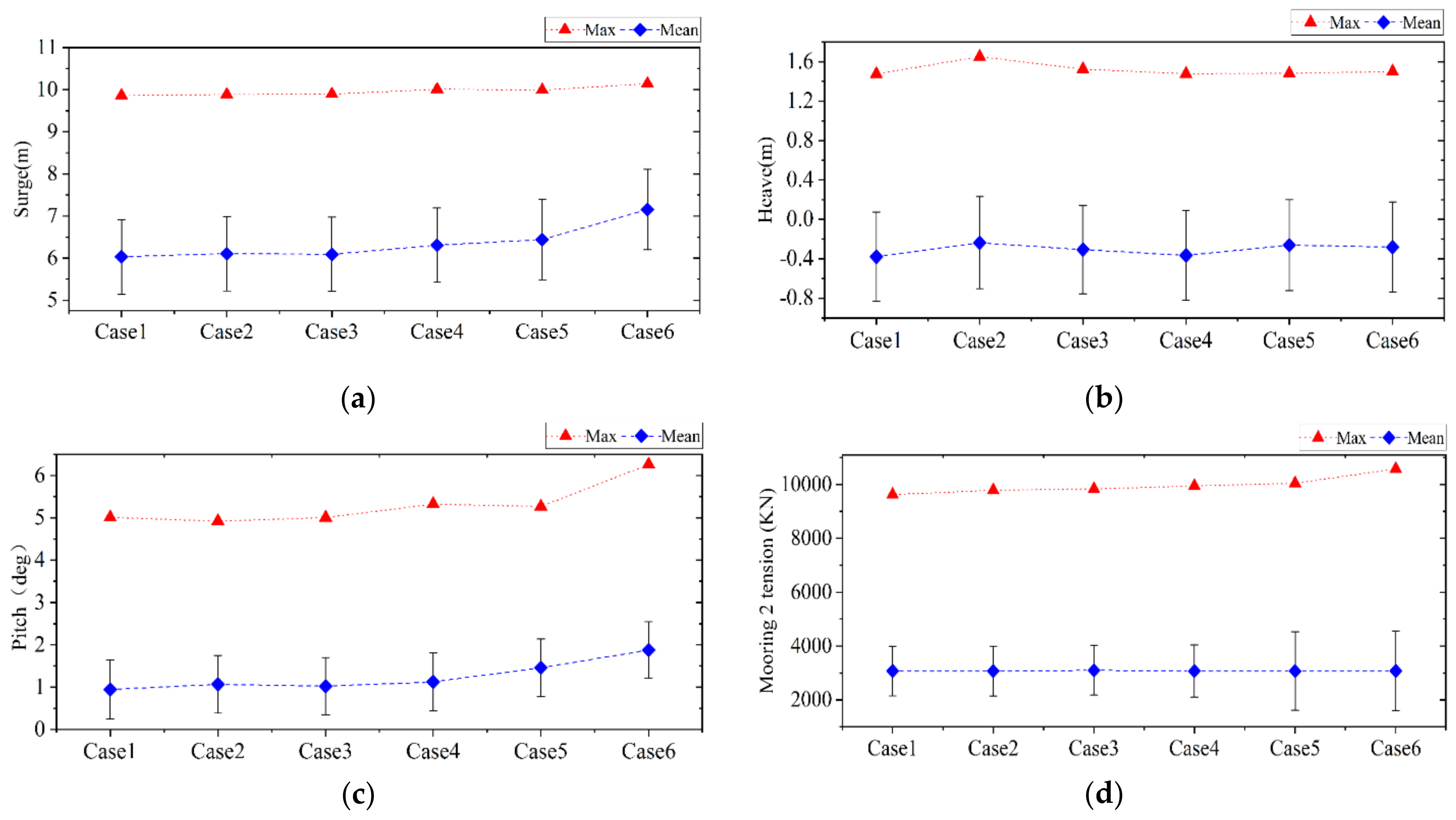
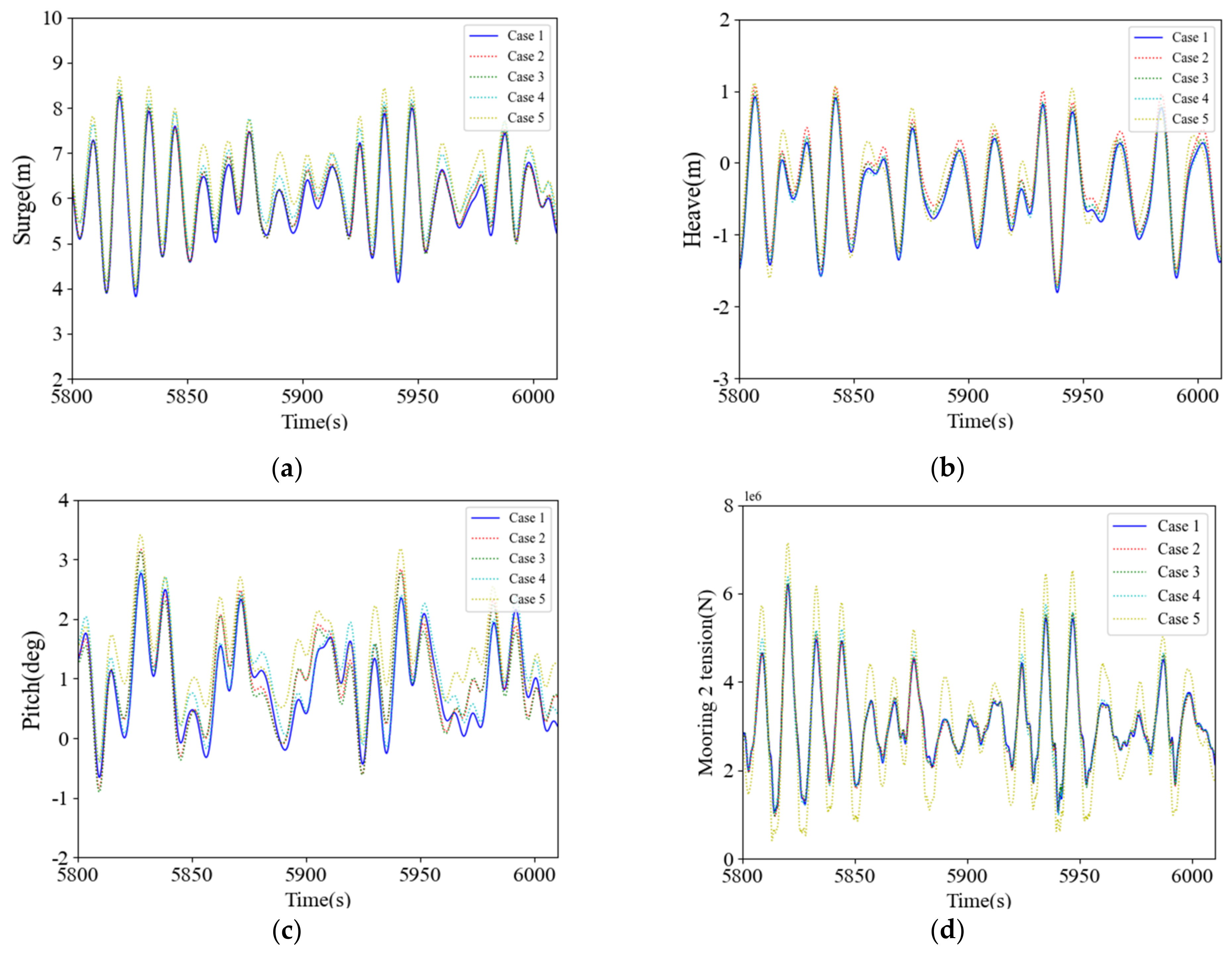
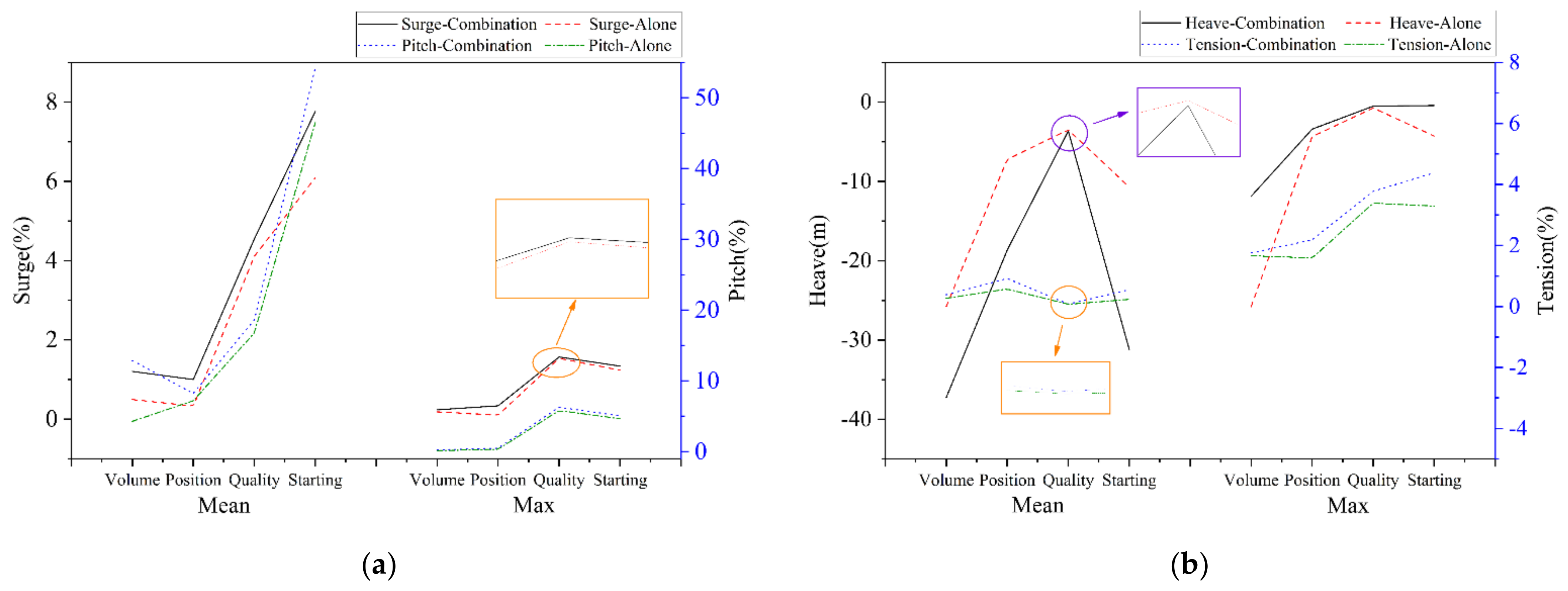
| Parameter | Value | Parameter | Value |
|---|---|---|---|
| Rated power (MW) | 5 | Cut-out wind speed (m/s) | 25 |
| Cut-in wind speed (m/s) | 3 | Rotor diameter (m) | 126 |
| Rated wind speed (m/s) | 11.4 | Hub height (m) | 90 |
| Nacelle mass (t) | 240 | Tower mass (t) | 249.718 |
| Parameter | Value |
|---|---|
| Platform mass (including ballas)/kg | 1.3473 × 107 |
| Center of Mass (CM) location, below SWL/m | −13.46 |
| Depth of base platform, below static water level (SWL) (total draft)/m | 20 |
| Platform roll inertial about CM/(kg·m2) | 6.827 × 109 |
| Platform pitch inertial about CM/(kg·m2) | 6.827 × 109 |
| Platform yaw inertial about CM/(kg·m2) | 1.226 × 1010 |
| Parameter | Value | Parameter | Value |
|---|---|---|---|
| Type of mooring system | catenary | Type of mooring system | tension |
| Number of mooring lines | 3 | Number of mooring lines | 3 |
| Mooring line length/m | 320 | Mooring line length/m | 313 |
| Breaking strength/KN | 13,583 | Breaking strength/KN | 12,790 |
| Depth to anchors/m | 40 | Depth to anchors/m | 40 |
| Fairlead depth/m | 14 | Fairlead depth/m | 14 |
| Dry weight/kg/m | 299.5 | Dry weight/kg/m | 357.7 |
| Anchor distance from platform center/m | 352.87 | Anchor distance from platform center/m | 352.87 |
| Mooring line diameter/m | 120 | Mooring line diameter/m | 175 |
| Axial stiffness/MN | 1123.5 | Axial stiffness/MN | 318 |
| Load Cases | Value | |
|---|---|---|
| JONSWAP | 6.42 m | |
| 11.58 s | ||
| 21 m/s | ||
| 1.85 m/s | ||
| Mooring Mode | Response Type | Max | Min | Mean | STD |
|---|---|---|---|---|---|
| Tensioned | Surge/m | 4.758 | −3.557 | 0.7757 | 1.124 |
| Catenary | 8.988 | −4.386 | 4.337 | 0.9878 | |
| Tensioned | Heave/m | 2.869 | −3.124 | −0.2909 | 0.8235 |
| Catenary | 2.353 | −2.394 | −0.1490 | 0.6337 | |
| Tensioned | Pitch/° | 8.974 | −2.289 | 3.131 | 0.6784 |
| Catenary | 8.499 | −3.386 | 2.582 | 0.6465 | |
| Tensioned | Mooring 2 tension/KN | 6978 | -- | 1167 | 1216 |
| Catenary | 5846 | -- | 741 | 277.2 |
| Case | Buoy Volume/m3 | Buoy Position/m | Mass of Clump Weight/kg/m | Clump Weight Location/m |
|---|---|---|---|---|
| Case1 | 10 | 15 | 900 | 62.13 |
| Case2 | 20 | 15 | 900 | 62.13 |
| Case3 | 10 | 25 | 900 | 62.13 |
| Case4 | 10 | 15 | 700 | 62.13 |
| Case5 | 10 | 15 | 900 | 112.13 |
| Case6 | -- | -- | -- | -- |
| Response | Difference | Buoy Volume/% | Buoy Position/% | Mass of Clump Weight/% | Clump Weight Location/% |
|---|---|---|---|---|---|
| Surge | Mean | 7.08 | 0.672 | 0.439 | 1.674 |
| Max | 0.055 | 0.237 | 0.038 | 0.104 | |
| Pitch | Mean | 8.586 | 1.021 | 1.837 | 7.706 |
| Max | 0.098 | 0.1632 | 0.473 | 0.0417 | |
| Heave | Mean | 11.464 | 11.435 | 0.165 | 30.1 |
| Max | 24.6 | 0.96 | 0.236 | 3.856 | |
| Tension | Mean | 0.119 | 0.342 | 0.006 | 0.316 |
| Max | 0.093 | 0.597 | 0.386 | 1.087 |
Publisher’s Note: MDPI stays neutral with regard to jurisdictional claims in published maps and institutional affiliations. |
© 2022 by the authors. Licensee MDPI, Basel, Switzerland. This article is an open access article distributed under the terms and conditions of the Creative Commons Attribution (CC BY) license (https://creativecommons.org/licenses/by/4.0/).
Share and Cite
Zheng, X.; Zhang, T.; Hu, Z.; Ma, G. Study on Characteristics and Optimal Layout of Components in Shallow Water Mooring System of Floating Wind Turbine. Appl. Sci. 2022, 12, 10137. https://doi.org/10.3390/app121910137
Zheng X, Zhang T, Hu Z, Ma G. Study on Characteristics and Optimal Layout of Components in Shallow Water Mooring System of Floating Wind Turbine. Applied Sciences. 2022; 12(19):10137. https://doi.org/10.3390/app121910137
Chicago/Turabian StyleZheng, Xing, Tianyin Zhang, Zhenhong Hu, and Gang Ma. 2022. "Study on Characteristics and Optimal Layout of Components in Shallow Water Mooring System of Floating Wind Turbine" Applied Sciences 12, no. 19: 10137. https://doi.org/10.3390/app121910137
APA StyleZheng, X., Zhang, T., Hu, Z., & Ma, G. (2022). Study on Characteristics and Optimal Layout of Components in Shallow Water Mooring System of Floating Wind Turbine. Applied Sciences, 12(19), 10137. https://doi.org/10.3390/app121910137







